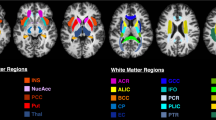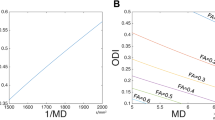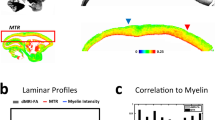Abstract
Purpose
In diffusion MRI (dMRI), it remains unclear to know how much increase of b-value is conveying additional biological meaning. We tested the correlations between cortical microarchitecture and diffusion metrics computed from standard (1000 s/mm2), high (3000 s/mm2), to very high (5000 s/mm2) b-value dMRI.
Methods
Healthy volunteers were scanned with a dMRI pulse sequence that was first optimized together with a T1-WI and T2-WI. Averaged cortical surface map of estimated myelin (T1-WI/T2-WI) was compared with surface maps of mean diffusivity (MD) computed from each b-value (MD1000, MD3000, and MD5000) and to surface map of mean kurtosis (MK computed from the 0-, 1000-, to 3000-s/mm2 shells) in 360 cortical parcels using Spearman correlations, multiple linear regressions, and Akaike information criteria (AIC).
Results
Surface map from MD1000 showed variations not related to myelin but the MD3000 and MD5000 maps inversely mirrored estimated myelin map; lower MD values being observed in more myelinated cortical areas. MK mirrored myelinated cortical areas. Quantitatively, Spearman correlations between myelin and MD became more and more negative as long as b-values increased while the correlation was positive between myelin and MK. Multiple regression models confirmed negative associations between myelin and MD that were significantly better from MD1000 to MD3000 and MD5000 (R2 = 0.33, p < 0.001; R2 = 0.43, p < 0.001; and R2 = 0.50, p < 0.001) and positive association between myelin and MK (R2 = 0.53, p < 0.001). Comparisons of the 3 statistical models showed the best performances with MK and MD5000 (AICMK < AICMD5000 < AICMD3000 < AICMD1000).
Conclusion
Higher b-values are more closely related to subtle cellular variations of the cortical microarchitecture.


Similar content being viewed by others
Funding information
The study was supported by public grants from the French Agence Nationale de la Recherche within the context of the Investments for the Future Program, referenced ANR-10-LABX-57 and named “TRAIL” (Translational Research and Advanced Imaging Laboratory).
Abbreviations
- AIC:
-
Akaike information criterion
- dMRI:
-
Diffusion magnetic resonance imaging
- DKI:
-
Diffusion kurtosis imaging
- DTI:
-
Diffusion tensor imaging
- FA:
-
Fractional anisotropy
- HCP:
-
Human connectome project
- MD:
-
Mean diffusivity
- MK:
-
Mean kurtosis
- NAq:
-
Number of acquisitions
- NDGD:
-
Number of diffusion gradient directions
- NODDI:
-
Neurite orientation dispersion and density imaging
- SS-EPI:
-
Single-shot echo-planar imaging
References
Le Bihan D (2013) Apparent diffusion coefficient and beyond: what diffusion MR imaging can tell us about tissue structure. Radiology 268(2):318–322. https://doi.org/10.1148/radiol.13130420
DeLano MC, Cooper TG, Siebert JE, Potchen MJ, Kuppusamy K (2000) High-b-value diffusion-weighted MR imaging of adult brain: image contrast and apparent diffusion coefficient map features. AJNR Am J Neuroradiol 21(10):1830–1836
De Santis S, Gabrielli A, Palombo M, Maraviglia B, Capuani S (2011) Non-Gaussian diffusion imaging: a brief practical review. Magn Reson Imaging 29(10):1410–1416. https://doi.org/10.1016/j.mri.2011.04.006
Dudink J, Larkman DJ, Kapellou O, Boardman JP, Allsop JM, Cowan FM, Hajnal JV, Edwards AD, Rutherford MA, Counsell SJ (2008) High b-value diffusion tensor imaging of the neonatal brain at 3T. AJNR Am J Neuroradiol 29(10):1966–1972. https://doi.org/10.3174/ajnr.A1241
Baumann PS, Cammoun L, Conus P, Do KQ, Marquet P, Meskaldji D, Meuli R, Thiran JP, Hagmann P (2012) High b-value diffusion-weighted imaging: a sensitive method to reveal white matter differences in schizophrenia. Psychiatry Res 201(2):144–151. https://doi.org/10.1016/j.pscychresns.2011.08.003
Glasser MF, Goyal MS, Preuss TM, Raichle ME, Van Essen DC (2014) Trends and properties of human cerebral cortex: correlations with cortical myelin content. Neuroimage 93(Pt 2):165–175. https://doi.org/10.1016/j.neuroimage.2013.03.060
Glasser MF, Van Essen DC (2011) Mapping human cortical areas in vivo based on myelin content as revealed by T1- and T2-weighted MRI. J Neurosci 31(32):11597–11616. https://doi.org/10.1523/JNEUROSCI.2180-11.2011
Glasser MF, Coalson TS, Robinson EC, Hacker CD, Harwell J, Yacoub E, Ugurbil K, Andersson J, Beckmann CF, Jenkinson M, Smith SM, Van Essen DC (2016) A multi-modal parcellation of human cerebral cortex. Nature 536(7615):171–178. https://doi.org/10.1038/nature18933
Nakamura K, Chen JT, Ontaneda D, Fox RJ, Trapp BD (2017) T1-/T2-weighted ratio differs in demyelinated cortex in multiple sclerosis. Ann Neurol 82(4):635–639. https://doi.org/10.1002/ana.25019
Jensen JH, Helpern JA (2010) MRI quantification of non-Gaussian water diffusion by kurtosis analysis. NMR Biomed 23(7):698–710. https://doi.org/10.1002/nbm.1518
Dietrich O, Raya JG, Reiser MF (2008) Magnetic resonance noise measurements and signal-quantization effects at very low noise levels. Magn Reson Med 60(6):1477–1487. https://doi.org/10.1002/mrm.21784
Jones DK, Knosche TR, Turner R (2013) White matter integrity, fiber count, and other fallacies: the do’s and don’ts of diffusion MRI. Neuroimage 73:239–254. https://doi.org/10.1016/j.neuroimage.2012.06.081
Glasser MF, Sotiropoulos SN, Wilson JA, Coalson TS, Fischl B, Andersson JL, Xu J, Jbabdi S, Webster M, Polimeni JR, Van Essen DC, Jenkinson M, Consortium WU-MH (2013) The minimal preprocessing pipelines for the Human Connectome Project. Neuroimage 80:105–124. https://doi.org/10.1016/j.neuroimage.2013.04.127
Tabesh A, Jensen JH, Ardekani BA, Helpern JA (2011) Estimation of tensors and tensor-derived measures in diffusional kurtosis imaging. Magn Reson Med 65(3):823–836. https://doi.org/10.1002/mrm.22655
Hui ES, Cheung MM, Chan KC, Wu EX (2010) B-value dependence of DTI quantitation and sensitivity in detecting neural tissue changes. Neuroimage 49(3):2366–2374. https://doi.org/10.1016/j.neuroimage.2009.10.022
Ganepola T, Nagy Z, Ghosh A, Papadopoulo T, Alexander DC, Sereno MI (2018) Using diffusion MRI to discriminate areas of cortical grey matter. Neuroimage 182:456–468. https://doi.org/10.1016/j.neuroimage.2017.12.046
Rowley CD, Bazin PL, Tardif CL, Sehmbi M, Hashim E, Zaharieva N, Minuzzi L, Frey BN, Bock NA (2015) Assessing intracortical myelin in the living human brain using myelinated cortical thickness. Front Neurosci 9:396. https://doi.org/10.3389/fnins.2015.00396
Melhem ER, Itoh R, Jones L, Barker PB (2000) Diffusion tensor MR imaging of the brain: effect of diffusion weighting on trace and anisotropy measurements. AJNR Am J Neuroradiol 21(10):1813–1820
Grinberg F, Farrher E, Kaffanke J, Oros-Peusquens AM, Shah NJ (2011) Non-Gaussian diffusion in human brain tissue at high b-factors as examined by a combined diffusion kurtosis and biexponential diffusion tensor analysis. Neuroimage 57(3):1087–1102. https://doi.org/10.1016/j.neuroimage.2011.04.050
Le Bihan D (2007) The ‘wet mind’: water and functional neuroimaging. Phys Med Biol 52(7):R57–R90
Clark CA, Le Bihan D (2000) Water diffusion compartmentation and anisotropy at high b values in the human brain. Magn Reson Med 44(6):852–859
Hui ES, Cheung MM, Qi L, Wu EX (2008) Towards better MR characterization of neural tissues using directional diffusion kurtosis analysis. Neuroimage 42(1):122–134. https://doi.org/10.1016/j.neuroimage.2008.04.237
Wu EX, Cheung MM (2010) MR diffusion kurtosis imaging for neural tissue characterization. NMR Biomed 23(7):836–848. https://doi.org/10.1002/nbm.1506
Zhang H, Schneider T, Wheeler-Kingshott CA, Alexander DC (2012) NODDI: practical in vivo neurite orientation dispersion and density imaging of the human brain. Neuroimage 61(4):1000–1016. https://doi.org/10.1016/j.neuroimage.2012.03.072
MacKay A, Laule C, Vavasour I, Bjarnason T, Kolind S, Madler B (2006) Insights into brain microstructure from the T2 distribution. Magn Reson Imaging 24(4):515–525. https://doi.org/10.1016/j.mri.2005.12.037
Fukutomi H, Glasser MF, Zhang H, Autio JA, Coalson TS, Okada T, Togashi K, Van Essen DC, Hayashi T (2018) Neurite imaging reveals microstructural variations in human cerebral cortical gray matter. Neuroimage 182:488–499. https://doi.org/10.1016/j.neuroimage.2018.02.017
Fukutomi H, Glasser MF, Murata K, Akasaka T, Fujimoto K, Yamamoto T, Autio JA, Okada T, Togashi K, Zhang H, Van Essen DC, Hayashi T (2019) Diffusion tensor model links to neurite orientation dispersion and density imaging at high b-value in cerebral cortical gray matter. Sci Rep 9(1):12246. https://doi.org/10.1038/s41598-019-48671-7
Jones DK, Alexander DC, Bowtell R, Cercignani M, Dell’Acqua F, McHugh DJ, Miller KL, Palombo M, Parker GJM, Rudrapatna US, Tax CMW (2018) Microstructural imaging of the human brain with a ‘super-scanner’: 10 key advantages of ultra-strong gradients for diffusion MRI. Neuroimage 182:8–38. https://doi.org/10.1016/j.neuroimage.2018.05.047
Setsompop K, Kimmlingen R, Eberlein E, Witzel T, Cohen-Adad J, McNab JA, Keil B, Tisdall MD, Hoecht P, Dietz P, Cauley SF, Tountcheva V, Matschl V, Lenz VH, Heberlein K, Potthast A, Thein H, Van Horn J, Toga A, Schmitt F, Lehne D, Rosen BR, Wedeen V, Wald LL (2013) Pushing the limits of in vivo diffusion MRI for the Human Connectome Project. Neuroimage 80:220–233. https://doi.org/10.1016/j.neuroimage.2013.05.078
Coupe P, Manjon JV, Chamberland M, Descoteaux M, Hiba B (2013) Collaborative patch-based super-resolution for diffusion-weighted images. Neuroimage 83:245–261. https://doi.org/10.1016/j.neuroimage.2013.06.030
Kidoh M, Shinoda K, Kitajima M, Isogawa K, Nambu M, Uetani H, Morita K, Nakaura T, Tateishi M, Yamashita Y, Yamashita Y (2019) Deep learning based noise reduction for brain MR imaging: tests on phantoms and healthy volunteers. Magn Reson Med Sci. https://doi.org/10.2463/mrms.mp.2019-0018
Alexander DC, Zikic D, Ghosh A, Tanno R, Wottschel V, Zhang J, Kaden E, Dyrby TB, Sotiropoulos SN, Zhang H, Criminisi A (2017) Image quality transfer and applications in diffusion MRI. Neuroimage 152:283–298. https://doi.org/10.1016/j.neuroimage.2017.02.089
Heath F, Hurley SA, Johansen-Berg H, Sampaio-Baptista C (2018) Advances in noninvasive myelin imaging. Dev Neurobiol 78(2):136–151. https://doi.org/10.1002/dneu.22552
Shafee R, Buckner RL, Fischl B (2015) Gray matter myelination of 1555 human brains using partial volume corrected MRI images. Neuroimage 105:473–485. https://doi.org/10.1016/j.neuroimage.2014.10.054
Funding
Anonymized data will be shared by request from any qualified investigator.
Author information
Authors and Affiliations
Contributions
Mournet, S., University Hospital of Bordeaux, France, analyzed the data; performed biostatistical analyses; interpreted the data; and drafted the manuscript for intellectual content.
Okubo, G., University Hospital of Bordeaux, France, designed and conceptualized the study; collected the data; computed surface maps; and revised the manuscript critically for intellectual content.
Koubiyr, I., University Hospital of Bordeaux, France, participated to image postprocessing and revised the manuscript critically for intellectual content.
Zhang, B., Canon Medical System, coordinated imaging acquisition for site, played a major role in the acquisition of data, and revised the manuscript critically for intellectual content.
Kusahara, H., Canon Medical System, played a major role in the elaboration of the diffusion sequence and revised the manuscript critically for intellectual content.
Prevost, V.H., Canon Medical System, participated to sequence optimization and revised the manuscript critically for intellectual content.
Ichinose, N., Canon Medical System, coordinated imaging acquisition for site; participated to sequence optimization; and revised the manuscript critically for intellectual content.
Triaire, B., Canon Medical System, coordinated imaging acquisition for site and revised the manuscript critically for intellectual content.
Hiba, B., University Hospital of Lyon, France, played a role in the acquisition of data and revised the manuscript critically for intellectual content.
Dousset, V., University Hospital of Bordeaux, France, designed and conceptualized study and revised the manuscript critically for intellectual content.
Tourdias, T., University Hospital of Bordeaux, France, designed and conceptualized study; interpreted the data; and drafted the manuscript for intellectual content.
Corresponding author
Ethics declarations
Conflict of interest
Zhang B, Kusahara H, Prevost V.H, Ichinose N and Triaire B are employees for Canon Medical.
Ethical approval
All procedures performed in the studies involving human participants were in accordance with the ethical standards of the institutional and/or national research committee and with the 1964 Helsinki Declaration and its later amendments or comparable ethical standards.
Informed consent
Informed consent was obtained from all individual participants included in the study.
Code availability
Not applicable.
Additional information
Publisher’s note
Springer Nature remains neutral with regard to jurisdictional claims in published maps and institutional affiliations.
Electronic supplementary material
Supplemental Figure 1:
(a) Cortical surface maps with black lines representing the HCP cortical parcellation. Yellow parcels correspond to the 72 thinnest cortical parcels. There are four views of the brain: left lateral (top left), left medial (bottom left), right lateral (top right) and right medial (bottom right). (b) MD within the 72 thinnest parcels along spatial resolution. Values are means ± standard error to the mean (SEM) and are normalized to the mean value at 1.3mm3 resolution. (c) MD and (d) FA within the 72 thinnest parcels along NDGD. Values are means ± SEM and are normalized to the mean value collected with 64 NDGD. ** p<0.01 and *** p<0.001 for Nemenyi post hoc tests with Bonferroni correction. (JPG 171 kb).
Supplemental Figure 2:
The left lateral view of the cortical surface maps averaged across the 9 subjects for MD1000, MD3000 and MD5000 showing a progressive decrease of MD along b-values (top line) but also, when window/level was adjusted individually, variations of MD values from one cortical area to another with different patterns according to b-values (bottom line). (PNG 1223 kb).
Supplemental Figure 3:
Left lateral view of the brain of cortical surface maps averaged across the 9 subjectsfor (a) FA1000, (b) FA3000, and (c) FA5000. (JPG 160 kb).
Supplemental Table 1:
details of MR sequence parameters and post-processing steps. (PDF 83 kb).
Rights and permissions
About this article
Cite this article
Mournet, S., Okubo, G., Koubiyr, I. et al. Higher b-values improve the correlation between diffusion MRI and the cortical microarchitecture. Neuroradiology 62, 1411–1419 (2020). https://doi.org/10.1007/s00234-020-02462-4
Received:
Accepted:
Published:
Issue Date:
DOI: https://doi.org/10.1007/s00234-020-02462-4




